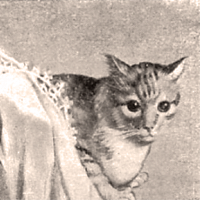There are a number of books on the market, some with traditional designs, some with more modern ones. I have quite a few. In my listing of the books that I have, I didn't list all the strictly pattern books, nor all the electronically scanned out-of-print and out-of copyright ones. I honestly have to stop myself from automatically buying a book on Assisi embroidery every time I come across one that I don't already have!
Almost 10 years ago I bought a yard of 28 ct 'Assisi' Graziano Linen from the US. By the time I factored in the exchange rate between the Canadian and American dollars (the Canadian dollar was not doing as good then as it is now) and the shipping, my yard cost me nearly $200 Canadian dollars. I'm happy to say that it is now easier and much less costly to have this lovely linen. And lovely it truly is! The threads are nice and plump and the fabric is weighty so that it makes great tablecloths, placemats, napkins, centres, doilies, you name it!
Traditional Assisi Embroidery is stitched on off-white coloured Assisi linen in either blue or rust coloured embroidery floss. The cross stitch can be regular x's or long-armed cross and the 'x' part should be made over three fabric ground threads. I've made a couple f scans of a piece that was a gift to me, made in Assisi. Outlines of the design are done first in a darker floss, black or dark brown with the Double Running Stitch. The fretwork is also executed in Double Running Stitch.

I love the combination of the voided work and the fretwork along the borders but most of all I love the hems! Four-Sided Stitch (done on this piece in off-white no. 8 pearl cotton) runs along the hemline (withdraw one or two ground threads for a more open effect) and the edge is finished with a rolled hem. I'm sad to say that I have never quite been able to achieve a rolled hem this small (or this neat!). The trick, I was told, is to wet your fingers with saliva and roll the fabric as you stitch. Here is the back of the same corner, notice how far into the rolled hem the hemstitches go in order to keep the roll in place... almost far enough to be seen from the front.

Of course I also love the tassels! Traditionally in groups of three, these tassels are made of no. 8 pearl cotton thread. The Anchor Manual of Needlework, which has quite an extensive section on Italian Needlework, has instructions on how to make these great little tassels.
You can read more on Assisi Embroidery at the Italian needlework website TuttoRicamo, click on the British Flag for the English pages and look under 'Techniques'. While you're there, you can download an old book on Assisi Embroidery from the early 20th century in .pdf format. Click on the first link under the 'Books' heading in the Assisi article, this will take you to another page. Under the first heading of 'Adele della Porta' you'll see the link. There are some great fantastical beasts in that book.
Here you can find 28ct Assisi linen made by another great Italian linen manufacturer, Sotema as well as many great Assisi pattern books by Mani di Fata
Tomorrow I'll tell you about some of the books I have on Assisi Embroidery that aren't strictly patterns only...
Assisi Embroidery Part Two
You can read more on Assisi Embroidery at the Italian needlework website TuttoRicamo, click on the British Flag for the English pages and look under 'Techniques'. While you're there, you can download an old book on Assisi Embroidery from the early 20th century in .pdf format. Click on the first link under the 'Books' heading in the Assisi article, this will take you to another page. Under the first heading of 'Adele della Porta' you'll see the link. There are some great fantastical beasts in that book.
Here you can find 28ct Assisi linen made by another great Italian linen manufacturer, Sotema as well as many great Assisi pattern books by Mani di Fata
Tomorrow I'll tell you about some of the books I have on Assisi Embroidery that aren't strictly patterns only...
Assisi Embroidery Part Two





thanks for sharing the information, i m a Pakistani, and very new to embroidery. fell in love with assisi work n just cant wait to start working on it.
ReplyDelete